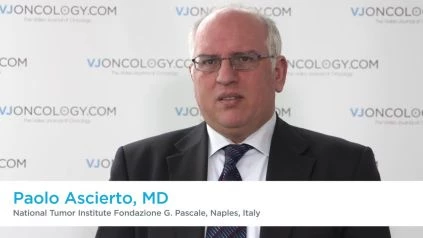Paolo Ascierto, MD, of the National Tumor Institute Fondazione G. Pascale, Naples, Italy, gives an overview of the use of biomarkers to select patients for checkpoint inhibitor therapy in melanoma at the European Cancer Congress of the European Cancer Organisation (ECCO) 2017 in Amsterdam, Netherlands. He says that there are currently no biomarkers in use to select patients who will benefit from checkpoint inhibitor treatment in melanoma, apart from tumor PD-L1 expression level, which is still controversial in melanoma. However, this is established in other types of cancer, such as the improved response to first-line treatment of metastatic non-small cell lung cancer (NSCLC) with the checkpoint inhibitor pembrolizumab compared to chemotherapy in patients with high tumor PD-L1 expression shown in the Phase III KEYNOTE-024 trial (NCT02142738). Prof. Ascierto discusses other biomarkers which may be important in determining which patients should receive checkpoint inhibitor therapy for melanoma; for example, baseline LDH expression, with retrospective analyses indicating that melanoma patients with elevated LDH may not respond well to checkpoint inhibitor treatment, but show a better response to ipilimumab and nivolumab treatment. Other potential biomarkers are the absolute lymphocyte and eosinophil count, the tumor microenvironment, immunoscore and immunoprofile. Particularly the IFNgamma signature is promising, as this was related to the outcome with pembrolizumab treatment in the KEYNOTE-001 trial (NCT01295827), while MHC expression profile may be related to progression on pembrolizumab treatment. In addition, mutations in beta-2-macroglobulin are related to acquired resistance, highlighting the value of baseline assessment of this marker. Prof. Ascierto also points out that a high mutation load as well as a mismatch repair deficiency appear to be linked to a good response to checkpoint inhibitor treatment in colorectal and other cancers. He argues that promising biomarkers for response to checkpoint inhibitor treatments in melanoma should be evaluated in prospective clinical trials to allow patients who will benefit from this treatment to be selected.
[the_ad id="32629"]

